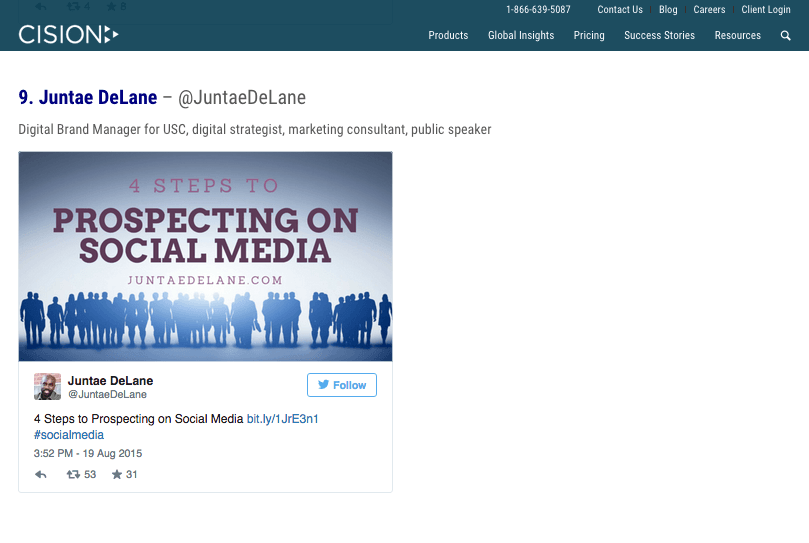Your blueprint to content marketing success begins with your left-brain-right-brain creativity.
I believe content marketing is both an art and science. Marketers who can utilize both halves of their brain will have success when creating a content marketing blueprint.

The perfect piece of content is one that uniquely gets the point across and reaches target consumers in a relevant fashion.
It’s not often I stumble across this type of content. When I do, it’s usually from an organization that has a team dedicated to creating awesome content. I assume the team is well equipped with content creators and content amplifiers. You know, a team of creative geniuses and mad scientist developing content that makes Steven Spielberg envious.
Unfortunately, we all don’t have resources to constantly create similar content for our brands. We do, however, have the ability to create a content marketing blueprint that will get us started.
Your 5-Step Blueprint to Content Marketing Success
If you’re looking to create a content marketing blueprint here’s the first step.
Step 1 – Determine Your Content Gaps
Your consumers are using the Internet to search for solutions to a problem. When wanting to know the best price for a television, they bargain shop. When wanting to know the effectiveness of an online course, they turn to reviews. When looking for a local seamstress to repair ripped jeans, they access the Internet on their mobile devices.
Creating a content marketing blueprint involves figuring out what pressing questions are going unanswered.
Look at search trends to understand your customer needs. I suggest using Google Keywords search to understand what keywords your customers’ are using to search for a business, product, or service.
Ultimately, when planning your content marketing campaigns, success starts with understanding what questions your customers have and how you can answer them best.
Consider the following questions:
- What questions do they have and how can you answer them best?
- What can you learn from influencers on your social channels?
- What topics and questions are they constantly revisiting?
Starting your content marketing plan with these questions in mind is key to its success. Ultimately, you want to create content that fills gaps in your marketing communications. For instance, if you have customers calling about how to use your product or service, try creating a video explaining the proper usage. This tactic may seem simple, but it’s very effective.

For new businesses, this process may produce limited results as it may not have a large enough customer base. If you consider yourself a newer business with a small customer base, I suggest choosing three to five major issues within your industry as content topics. Once you analyze engagements around this content, you can adjust your content marketing as needed.
Step 2 – Contact Influencers
Everyone loves an ego stroke now and then. People–especially influential people–would like acknowledgment for their work. Why do you think award shows are so popular. People like being recognized for being great. This human characteristic is something marketers have leveraged since 1849 when the Who’s Who book was published in the United Kingdom. This book has positioned itself as the source for information on the most influential people in the British culture.
A great way to develop relationships with influencers and build your content arsenal simultaneously is to feature them on an “industry expert” list.
This list could be top 50 social media influencers. Or top 40 under 40 lists.
Not only do influencers love the recognition, but they will help to amplify your content as well. These lists will shine a light on the content developer and the expert.
It’s a win-win.
Cision got my attention with its list of the top 50 social media influencers on Twitter:

So what does this mean for your content marketing success?
Read what your customers are reading. Learn what they care about and who they trust. Find existing discussion leaders in your industry. Interview them or invite them to write on behalf of your brand. Develop a list of influencers you want to recognize for their contribution to your industry.
Step 3 – Create An Editorial Calendar
As you can imagine, editorial calendars help you manage assignments, project due dates, and publishing schedules. The main point of the editorial calendar is to make your content marketing a collaborative process. Think of your editorial calendar to guide your team’s workflow. If you need help with creating an editorial calendar, I have developed a template I use for my blog here.
Step 4 – Look for Content Trends
It is important to consider content trends as a part of your content marketing blueprint. Think about it this way, when building a house you want to develop a blueprint similar to the other houses in the neighborhood. Right?
Here’s a Google Trends tutorial for ad buying but it can be used to create great content as well.
When you consider your content marketing blueprint, you need to consider the popular content trends for your industry.
Step 5 – Measure Your Content Marketing
The last step in your content marketing blueprint is measurement. Learning who is consuming your content is just as important as the development. Find out why they’re interested, and what additional steps they are taking with your brand.
Choosing the right metrics to make sure that you are capturing all stages of the conversion funnel – website visitors, social media shares, newsletter sign-ups, offer downloads, and sales.
Use these metrics to figure out what’s working and then amplify those efforts. Remember, your content can evolve and catch fire long after it’s published. Be sure to continuously track engagements to understand what content is outperforming the rest.
Particularly, content with high traffic may not be your best performing piece. Like you, I can be influenced by vanity metrics such as views and shares. But sometimes, I must remind myself of what’s most important: conversions.
I suggest you prioritize conversion tracking above all else. Perhaps this is the most important metric in your content marketing blueprint.
Conclusion
Your organization can create great content that meets both your business and consumers’ objectives. If you create a balanced approach to developing your content marketing blueprint, you can create content that competes with the biggest brands in your industry. It all starts with fusing the art and science of content creation and amplification. Once you consider this approach, you are well on your way to creating a blueprint that leads to content marketing success.













